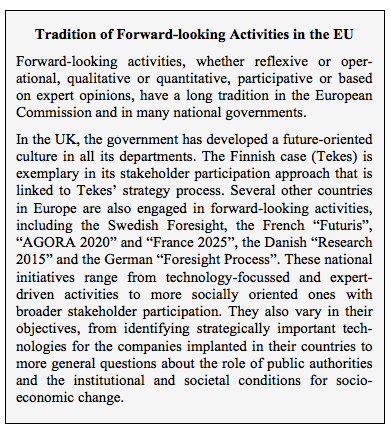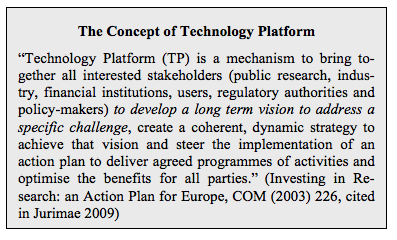As a part of the Ljubljana Process of governance of ERA, which was launched by the EU Commission and Council in May 2008, a common 2020 vision for the European Research Area was adopted on 2 December 2008. This vision stipulates that: “[…] by 2020, all actors should fully benefit from the free circulation of researchers, knowledge and technology.”1 Forward looking activities are indis-pensable for promoting the policy process of the ERA vision 2020 in order to speak with one voice, to jointly promote consistency between their R&D cooperation activities, and to develop joint initiatives that give Europe leadership in addressing global challenges and reaching sustainable development goals.
ERA Vision 2020
The 2020 Vision for the European Research Area (ERA) was developed in partnership by all member states and the European Commission and in consultation with associated countries. When adopting the 2020 Vision, the Council of the European Union invited member states and the European Commission to communicate it widely to stakeholders and society at large and to quickly focus policies and actions to make it a reality.
1 European Research Area Vision 2020 – http://ec.europa.eu/research/era/2020_era_vision_en.html
2 http://ec.europa.eu/research/era/2020_era_vision_en.htm
By 2020, all players are supposed to fully benefit from the Fifth Freedom3 across the ERA, which refers to the free circulation of researchers, knowledge and technology. The ERA is intended to provide attractive conditions and effective and efficient governance for carrying out research and investing in R&D intensive sectors in Europe. It seeks to create significant added value by fostering scientific competition throughout Europe whilst ensuring the appropriate level of cooperation and coordination. It is envisaged to be responsive to the needs and ambitions of citizens and to effectively contribute to the sustainable development and competitiveness of Europe.
3 The Fifth Freedom is derived from European Union law where the Four Freedoms is a common term for a set of treaty provisions, secondary legislation and court decisions, protecting the ability of goods, capital, services, people and labour to move freely within the internal market of the European Union. More precisely, they are the free movement of goods, the free movement of capital, the free movement of services and the free movement of persons.
The ERA Vision 2020 is predicated on the insight that good European governance must be based upon strategic forward thinking. This involves defining major societal challenges, underpinning the selection of themes in joint programming and helping to prioritise and focus research, thus laying the groundwork for future-oriented strategic thinking. The ex-ante analysis of societal trends in the world and the European Union on the basis of scenarios and identifying potential breakthroughs (“wild cards”) are all elements that allow decision-makers to highlight their choices under a new perspective.
Forward-looking Activities to Promote ERA
The European Commission, following up on its commitment to help member states better coordinate their research efforts, organised a conference session on forward-looking activities in October 2009 that underpinned the ERA vision 2020.4
Experts, representatives of the public sector and directors of DG Research attempted to identify the needs in this field. The participants discussed how a continuous process of forward-looking and horizon scanning activities for ERA could be organised in the future, how to ensure that this approach would lead to a better support and further integration of national research policies in ERA, and what could be the drivers to determine potential “grand challenges” and joint programming priorities.
Three-dimensional Strategy
During the session, Anneli Pauili, the deputy Director-General of DG Research, reflected on the main principle guiding forward-looking activities promoted by the EC, which is to combine three dimensions in these activities: ensuring that the abundance of information provided by experts is taken into consideration, involvement of stakeholders (researchers, companies, NGOs and public organisations), and involvement of relevant politicians to increase the likelihood of results being considered in policy-making.
Added Value through Joint Programming
At European level, there exist various networks, tools and systems to follow up on forward-looking activities. Consensus is growing that European research policy needs to be based on more systematic, continuous, forward-looking and pan-European activities. It is particularly important that member states and associated countries combine their research efforts through “joint programming”, which must not be content with simply finding the lowest common denominator but should rather strive to merge different perspectives and multiple visions of the future. Here is the clear link with the Lund declaration5 that stipulates, “The identification of major challenges must involve the relevant stakeholders, including European institutions, business, public sector, NGOs and the scientific community, and foresee the interaction with international partners.”6
4 http://ec.europa.eu/research/conferences/2009/era2009 /programme/programme_22-10_en.htm
5 The Lund Declaration (SE), adopted on 9 July 2009 at the “New Worlds – New Solutions” conference, stipulates that the EU must identify the major challenges for which public and private research need to develop sustainable solutions.

Forward-looking Activities Support Innovation Policies
In recent years, forward-looking activities have been used intensively to support impact assessment for climate action policies, and there have been unprecedented levels of employing such activities in day-to-day policy-making in many countries and in the EC. Within research and innovation policies, forward-looking activities have a corrective role (addressing deficiencies and systemic failures and policy lock-ins), a disruptive role (encouraging an emphasis on crisis or breakthrough events that can completely change the current status quo), a creative role (stimulating the conditions whereby new networks and structures can evolve and grow) and a more embedded role as an instrument of articulating, structuring and delivering research and innovation policy.
6 Interview with Anneli Pauili, the deputy Director-General of DG Research, Special Issue – Research EU – November 2009, http://ec.europa.eu/research/research-eu/era/article_era40_en.html
Barriers to Networking
The major barriers to networking in the related fields and thus to the integration of national approaches of forward-looking activities are the uncertainty surrounding sufficient funding, the unnecessary rivalry among modelling teams for access to funds and the frequent lack of sufficient size, variety and multi-disciplinarity of modelling teams.
New Wave of Interest in Foresight
The context of crisis and challenges has led to a new wave of interest in foresight, as alternative solutions and promising ways of moving forward are sought. Foresight has now become a pervasive activity at the institutional level to inform programme planning and to support structural change. Its role in EU Framework Programmes (FP) and ERA needs to be grounded in a greater involvement of stakeholders and users to encourage them to take ownership of the exercises. On the supply side, there is a need to maintain and extend the foresight community through support for research and community building activities and to help carry the results beyond their initial audience.
Common Understanding of the Potential of Forward-looking Activities
The ERA Conference 2009 resulted in a common understanding that forward-looking activities can be used in defining the future research activities, the annual work programmes, joint programming and international cooperation. In order to further shape the ERA vision 2020, forward-looking activities will have to
- help reinforce the governance culture by integrating the long-term perspective and giving more space to cross-cutting issues,
- help improve the quality and impact of European, national and regional research policies by comparing findings and methods and, consequently, by contributing to improved policy design and implementation at the European, national and regional level,
- support model development, human capital of modellers and long-lasting capacity and network of models, modellers and databases on a transnational basis.
To be successful, forward-looking activities need the commitment and involvement of the initiator.
Improving Foresight in Research and Policy
Better Networking and Sharing of Resources
For the future of the European Research Area (institutional, organisational, methodological, etc.), networking and sharing of resources (data, mathematical methods, policy advice experience and skills) are very important, provided that the network has some degree of variety and stability over time.
Better coherence – which does not mean harmonisation or standardisation – among forward-looking exercises at various levels, better access to each other’s knowledge, sharing and networking would support future decision-making. European forward-looking activities should not be limited to the aggregation of national forward-looking activities but should be set up as a truly European project, preferably putting together interoperable visions that can be exploited by decision-makers.
Interoperable Visions: European Technology Platforms
The forward looking approaches of some European Technology Platforms are good examples for such interoperable visions. The European Technology Platforms provide a framework for stakeholders, led by industry, to define research and development priorities, timeframes and action plans on a number of strategically important issues where achieving Europe’s future growth, competitiveness and sustainability objectives is dependent upon major research and technological advances in the medium to long-term. They play a key role in ensuring an adequate focus of research funding on areas with a high degree of industrial relevance, by covering the whole economic value chain and by mobilising public authorities at national and regional levels. As such, they are proving to be powerful actors in the development of European research policy, in particular in orienting the FP7 programs (including the “Cooperation Programme”) to better meet the needs of industry.

The following are some examples of technology platforms with a forward-looking approach for 2030 and beyond:
- European Biofuels TP (EBTP)
- European Construction TP (ECTP),
- European Steel TP (ESTEP)
- Forest-based sector TP (FTP)
- European Photovoltaic TP
- European TP on Sustainable Mineral Resources (ETP SMR)
- Sustainable Nuclear Energy TP (SNE-TP)
- European Wind Energy TP (TPWind)
- Water Supply and Sanitation European TP (WSSTP)
Maintain Continuous Process
A continuous process of integrated forward-looking activities should be organized (joint programming), comprising cooperation between policy-making EU Directorate-Generals and ERA in order to make sure that forward-looking analytical capacity is established, well networked and disposes funding to ensure high quality and state-of-the-art methods. It is important thereby to ensure continuity and stability to modelling teams.
Optimise Integration of Foresight
in Governance Processes
A lot of work has been done at the European level in the “research” component of forward-looking activities but a lot has still to be done in the “policy” component of those activities; that is, “foresight” done by researchers and experts should be better integrated into the policy-oriented foresight process where policy-makers and stakeholders (including citizens) should participate.
Forward-looking methods have to be combined and integrated as much as possible in the “policy cycle”, taking stock of appropriate structures for defining research agendas, such as the European Technology Platforms and Social Platforms. Policy-makers, stakeholders (ministries, universities, industries, research centres and civil society organizations) should participate and work together. Both bottom-up (researchers, experts) and top-down (policy-makers) involvements are needed. Endogenous technology dynamics including their complex interactions with society, economy and energy have to be applied.
| Authors: | Anette Braun braun_a@vdi.de
Axel Zweck zweck@vdi.de |
||||||
| Sponsors: | Pierre Valette, European Commission – DG Research – Directorate L – Science, Economy and Society Unit L2 – Research in the Economic, Social Sciences and Humanities – Prospective | ||||||
| Type: | European/international | ||||||
| Organizer: | European Commission – DG Research – European Research Area | ||||||
| Duration: | 2008 | Budget: | N/A | Time Horizon: | 2020 | Date of Brief: | Dec. 2009 |
Download EFP Brief No. 168_ERA Vision 2020
Sources and References
European Research Area Vision 2020:
http://ec.europa.eu/research/era/2020_era_vision_en.html, http://ec.europa.eu/research/era/pdf/2020-vision-for-era_en.pdf
ERA 2009 Conference:
http://ec.europa.eu/research/conferences/2009/era2009/programme/programme_22-10_en.htm
Interview with Anneli Pauili, the deputy Director-General of DG Research, Special Issue – Research EU – 11/ 2009, http://ec.europa.eu/research/research-eu/era/article_era40_en.html
Tiit Jurimae, The experience of European Technology Platforms (ETPs) as a vision-building process, 2009, http://ec.europa.eu/research/era/pdf/event01/ev01-17-tiit-jurimae_en.pdf